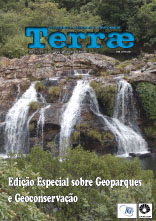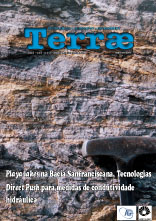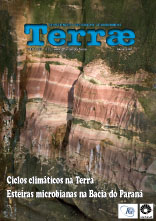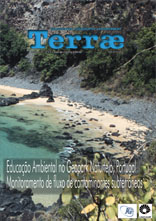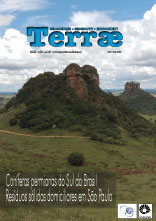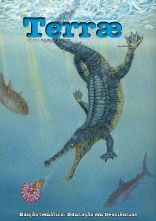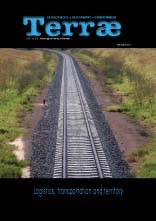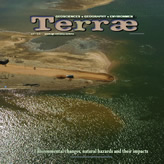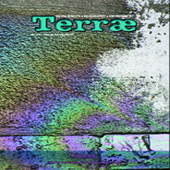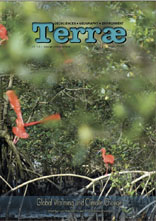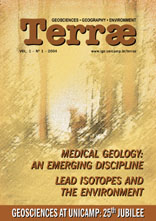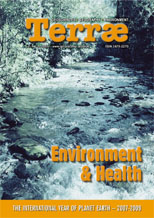Save the date / Call for papers
A revista Terræ publica simultaneamente as edições online de 2016 e 2017. As edições impressas acham-se temporariamente suspensas, pois os editores reconhecem que a internet oferece formas mais eficazes para disseminar rapidamente os resultados das pesquisas. As reformulações do periódico objetivam ampliar a abrangência, combinando redução de custos com rapidez de publicação. Cada vez mais a revista consolida a tendência de cobrir temas multidisciplinares que revelem formas de interação das Geociências com as diferentes áreas do conhecimento humano. A edição de Terræ 2017 é inteiramente dedicada ao tema GEOPARQUES.
A revista aceita trabalhos e comunicações em Português, Inglês e Espanhol.
Chamada de trabalhos / CALL FOR PAPERS
Uma vez recuperado o tempo de ausência na web, a edição de Terræ 2018 tornar-se-á uma boa opção para publicação de artigos científicos. O volume deverá reunir contribuições referentes a GEOÉTICA, tema que permite acomodar abordagens diferenciadas que revelem as inter-relações entre a sociedade e os ecossistemas terrestres.
O sistema de submissão e avaliação de artigos científicos está em pleno funcionamento, sendo feito exclusivamente pelo E-mail: terrae@ige.unicamp.br. Nosso sítio web está à sua disposição.
Esperamos sua visita e participação!
Os editores.
10/01/2018- 16:31 pm
Chamada de trabalhos/ Call for papers para o Volume 15, 2018
Novas contribuições são aceitas para o volume 2018 de Terræ.
Data limite 30.abril.2018
10/01/2018- 16:31 pm
Chamada de trabalhos/ Call for papers para os eventos:
VIII GeoSciEd 2018 – the 8th Quadrennial Conference of the
International Geoscience Education Organisation (IGEO)
– Geosciences for Everyone –
VIII Simpósio Nacional de Ensino e História de
Ciências da Terra / EnsinoGEO-2018
– Geociências para Todos –
Campinas – Sao Paulo – Brazil, July 2018
Acesse o site: http://www.ige.unicamp.br/geoscied2018/en/.
Data limite 11.fevereiro.2018
11/01/2018- 13:40 pm
Livro "Geologia do Brasil”, 2012: Reserve já seu exemplar, sem despesas de remessa.
Visite o endereço eletrônico: www.editorabeca.com.br
Os editores
Campinas, janeiro de 2018.
Guidelines for production of manuscripts
Each issue of Terræ focus on a relevant theme of Geology and Geography, as well as contributions on different subjects within the scope of the journal. Manuscripts on Earth Science and Geography education and teaching materials are made available on Terræ Didatica, also available in the web.
Guidelines for manuscript preparation
Articles should have from 4,000 to 6,000 words and be no longer than 15 pages, double-spaced pages including tables, figures, and references. They must be typed using Times New Roman 12, on one side only of A4-size paper and with the following margins: Top and Bottom – 2,5 cm; Left and Right – 2,0 cm.
Shorter articles are also acceptable. Scientific Communications should have around 2,000 words or 6 pages, double-space, including tables, figures and references.
Word-processors files are preferred. Manuscripts prepared with other software and computers should export the full text (with figures, schemes and tables inserted into the text) to a format as RTF, DOC or DOCX.
Articles must be written in English with American spelling, including units and numbers format. Authors whose native language is not English are strongly urged to have their manuscript reviewed before submission by a person whose native language is English.
Consecutive numbering of all pages is required, with the title page as page 1. The following format of presentation should be followed: title; authors’ names; authors’ affiliations and addresses; abstract; keywords; introduction; materials and methods; results; discussion; acknowledgments; references; tables; figure legends; and figures.
All highlights in the text must be in italic: never use underline. Bold is used just to volume numbering of journal references.
An abstract of no more than 200 words must be included as well as 3 to 5 keywords. It must emphasize the novel aspects and summarize the main findings of the paper for a general Geosciences reader.
Acknowledgements may be included in a brief statement at the end of the article. Metric units should be used and all nonstandard symbols, abbreviations and acronyms must be defined.
References should be inserted in parentheses in the text in full for single and dual authored papers (e.g. Forstner and Wittman 1981), but using first author and et al. for multiple authored papers (e.g. Gibson et al. 1995) or (Foxall 1998, Gibson et al. 1995). A List in alphabetical order must be included at the end of the article.
References to books should cite the author(s), publication date, title, publisher, and chapter pages, with the enhancement made always in italic. Journal references must cite the title of the paper, and its starting and ending pages. The following examples also includes a serial publication, a map, an abstract, a report of a meeting, and a textbook, in the following standard form:
Butt C.R.M., Zeegers H. eds. 1992. Regolith Exploration Geochemistry in Tropical and Subtropical Terrains. Handbook of Geochemistry. Amsterdam: Elsevier.
Chow T.J., Snyder C.B., Earl J.L. 1975. Isotope ratios of lead as pollutant source indicators. In: Isotope ratios as pollution source behavior indicators symposium. Vienna, IEAE. Proceedings, p. 95-108.
Dartmouth Flood Observatory. Floods. URL: http://www.dartmouth.edu/artsci/geog/floods. Last accessed: june 2nd, 2004.
Foxall S.L.J. 1998. Geographic education in Colorado: a view from the seventh grade. Fort Collins: Poudre Press.
Forstner U., Wittman G.T.W. 1981. Metal Pollution in the aquatic environment. Berlin: Springer-Verlag. 486p.
Gibson S.A., Thompson R.N., Leonards O.H., Dickin, A.P., Leonardos O.H. 1995. High-Ti and low-Ti mafic potassic magmas: key to plume-lithosphere interactions and continental flood-basalt genesis. Earth Planet. Sci. Lett., 136:189-229.
Green S., Sanderson F.J., Marsh T.J. 1996. Evidence for recent instability in rainfall and runoff patterns in the Celtic regions of W. Europe. In: 1st Inter-Celtic colloquium on Hydrology. Rennes, July, 1996. Proceedings... Paris: INRA.
Jones G.D. 1999. Numerical modelling of saline groundwater circulation in carbonate platforms. PhD thesis. Bristol: University of Bristol. 330p.
Kelly P.M., Jones P., Briffa, K. 1997. Classifying the winds and weather. In: Hulme M., Barrow, E. (eds.). Climates of the British isles. London: Routledge. p. 153-72.
Loster T. 1999. Flood trends and global change. In: Proceedings of the Euroconference on global change and catastrophe risk management: flood risks in Europe. IIASA, Laxenburg . URL: http://www.iiasa.ac.at/Research/RMP/june99/papers/loster.pdf Last accessed: Sept 6th, 2004.
Nunes A.R. 2002. Análise de dados geológicos, geofísicos e de sensoriamento remoto para geração de modelos prospectivos para a Região da Serra Leste, Carajás (PA). Campinas: Inst. Geoc., Univ. Est. Campinas / Unicamp. 217p. (MSc. dissertation).
Santos M. 1994. Técnica, espaço e tempo: globalização e meio técnico-científico informacional. São Paulo: Hucitec. 190p.
Toledo C.L.B. 2002. Evolução geológica das rochas máficas e ultramáficas no greenstone belt Barbacena, região de Nazareno, MG. Campinas: Inst. Geoc., Univ. Est. Campinas / Unicamp. 217p. (PhD Thesis).
Tables should be numbered and cited in numerical order in the text. Each table should be printed on a separate page, provided with a heading, and referred to in the text as Table 1, Table 2, etc. The title should be typed above each table. Legends giving sufficient explanation to make the data understandable without reference to the text must be typed below the table on the same page.
Figures must be cited in the text in numerical order using Arabic numerals. Figures should be numbered according to the sequence of their appearance in the text, where they are referred to as (Fig. 1) or Figure 1, (Fig. 2) or Figure 2 etc. The approximate point of insertion of figures must be indicated in the text. Figure legends should be typed on a separate sheet, and should include a brief title and a concise explanation of each figure. Conference slides, video sequences, software, etc., can be included and published as supplementary material.
Tables, figures and all graphics with words must be typed using Times New Roman or Arial.
The Results and Discussion section should emphasize the major findings of the research and their significance. Concise interpretation of scientific data and comparisons with the current literature should be included.
Illustrations
Good illustrations are essential and may include photographs, figures, line drawings or tables incorporating graphics. Tables with text only and without graphics may be placed by the author within the text of the article for typesetting by Terræ staff. Alternatively, other illustrations may be compiled in a standard spreadsheet package and submitted by e-mail or on diskette along with details of the software used. Although authors are encouraged to include figures and schemes in color, their use must be restricted to situation in which they are necessary on scientific, and not merely cosmetic, grounds. The Editor reserves the right to refuse color figures that do not comply with this condition.
It is not necessary to place captions on any illustrations but indicate where in the text they may be included. Illustrations previously published and unchanged from the original must be accompanied by permission from the original publisher to republish.
Illustrations (figures) should not be inserted into the text but sent in separated files. Originals should not be greater than A4 size and lettering should be capable of being reduced to up to 60 percent. TIFF format for Bitmap images is preferred. For vectorial images (lineart/line drawing), the following formats can be used: .AI (Adobe Illustrator), .CDR (CorelDraw), .CMX (Corel Presentation Exchange). Both vector and bitmap images can be sent in .EPS (Encapsulated PostScript) format.
Submission of Manuscripts
Manuscripts should be written in English, and submitted in printed form (three good copies), with a cover letter, including the author's name and all relevant contact addresses, to the following address:
TERRÆ, Editor-in-Chief
Instituto de Geociências - Universidade Estadual de Campinas - UNICAMP
R. João Pandiá Calógeras, 51
CEP: 13083-970
Fone: +55 (19) 3521-4554 / 3521-4551 - Fax +55 (19) 32891097
e-mail: terrae@ige.unicamp.br
The Editor cannot guarantee that an article will be published on a particular date or in a particular issue of Terræ. The Editor reserves the right to reject all or any part of the article submitted. The Editors assume no responsibility for statements made by contributors.
Copyright © 2003 - Institute of Geosciences - University of Campinas - UNICAMP - Brazil - All rights reserved
A PDF reader is required to view the article files. Make the download here: Adobe Acrobat or Foxi


